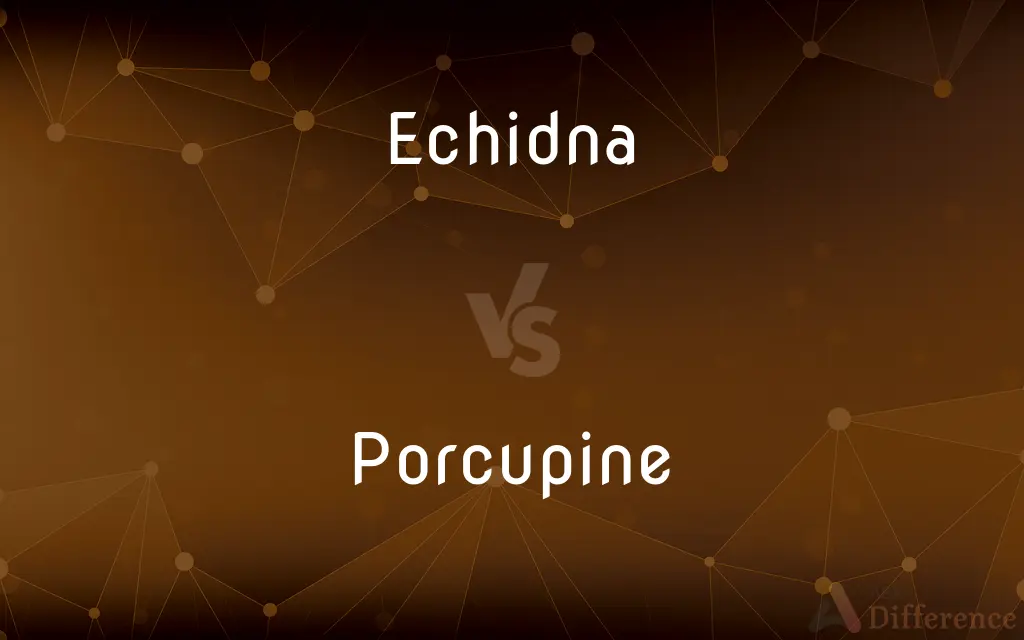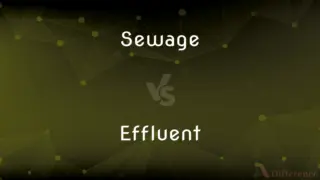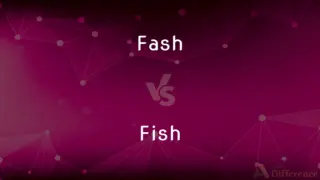Echidna vs. Porcupine — What's the Difference?
By Tayyaba Rehman — Updated on October 12, 2023
An echidna is a spiny, egg-laying mammal native to Australia and New Guinea, while a porcupine is a rodent with sharp quills covering its back, found in Americas, Europe, and Asia.

Difference Between Echidna and Porcupine
Table of Contents
ADVERTISEMENT
Key Differences
An echidna, endemic to Australia and New Guinea, carries a distinct profile in the animal kingdom. Echidnas are peculiar yet fascinating creatures, setting them apart in the realms of wildlife with their spiky appearance and reproductive habits. These creatures lay eggs and possess a beak-like snout, contributing to their unique identity among mammals. The echidna traverses its native landscapes with an undulating motion, meandering through its natural habitat with modest speed and deliberate movement.
Contrarily, porcupines, though also adorned with a shield of spines, embody a wholly different biological narrative. The porcupine, predominantly found in the Americas, Europe, and Asia, is a rodent and does not lay eggs like echidnas. Porcupines also exhibit a rather adventurous arboreal lifestyle, nimbly navigating through trees with surprising agility, showcasing a striking contrast to the terrestrial preference of echidnas.
Echidnas project an image of solitary and introverted creatures, often spending their time alone, burrowing through the ground in search of ants and termites. Their long, slender snouts and lengthy tongue enable them to adeptly access their invertebrate prey, demonstrating an intriguing adaptation to their dietary preferences. Notably, echidnas belong to a group called monotremes, which uniquely encapsulates egg-laying mammals.
Porcupines are similarly solitary but exhibit different social and feeding behaviors compared to echidnas. With a diet primarily composed of plant material like bark, porcupines showcase nocturnal habits, venturing out in the shroud of night to forage and feed, remaining elusive and somewhat mysterious in their nocturnal escapades. Their quills, unlike echidna spines, detach easily, providing a defensive mechanism against predators that might engage them.
Moreover, echidnas, with their spiky demeanor and waddling gait, forge a unique ecological niche. Their role in the ecosystem is defined by their ant and termite-heavy diet, influencing the population dynamics of these small invertebrates, and indirectly affecting the environment by modulating the activities of these decomposers.
ADVERTISEMENT
Alternatively, porcupines, through their herbivorous endeavors, shape their surroundings differently, impacting vegetation and sometimes even engaging in a subtle battle with humans when their appetites bring them into agricultural territories. Thus, porcupines, with their prickly defense and discerning palate for vegetation, weave a different ecological tale compared to echidnas.
Comparison Chart
Location
Australia and New Guinea
Americas, Europe, and Asia
Reproduction
Egg-laying (Monotreme)
Gives birth to live young
Diet
Primarily ants and termites
Primarily plant material
Quill Properties
Spiky but do not detach easily
Quills can detach easily
Lifestyle
Terrestrial, solitary
Arboreal or terrestrial, solitary
Compare with Definitions
Echidna
An echidna is a monotreme, laying eggs instead of giving birth.
The echidna is one of only a few mammals that lay eggs.
Porcupine
Porcupines are usually nocturnal.
In the dark, the porcupine began its nightly foraging.
Echidna
Echidnas are often solitary and slow-moving.
The lone echidna burrowed quietly through the underbrush.
Porcupine
Porcupines are covered in sharp, detachable quills.
The porcupine raised its quills in defense when threatened.
Echidna
Echidnas often eat ants and termites.
The echidna used its long tongue to capture ants.
Porcupine
Porcupines primarily consume plant material.
The porcupine was found munching on tree bark.
Echidna
Echidnas are covered with spines for defense.
The predator avoided the echidna due to its sharp spines.
Porcupine
Porcupines belong to the rodent family.
Despite its quills, the porcupine is actually a large rodent.
Echidna
Echidnas are native to Australia and New Guinea.
I spotted an echidna while traveling through Australia.
Porcupine
Porcupines can be found in various continents.
Porcupines inhabit regions in Asia, Europe, and the Americas.
Echidna
Echidnas (), sometimes known as spiny anteaters, belong to the family Tachyglossidae in the monotreme order of egg-laying mammals. The four extant species of echidnas and the platypus are the only living mammals that lay eggs and the only surviving members of the order Monotremata.
Porcupine
Porcupines are large rodents with coats of sharp spines, or quills, that protect them against predation. The term covers two families of animals: the Old World porcupines of family Hystricidae, and the New World porcupines of family Erethizontidae.
Echidna
A spiny insectivorous egg-laying mammal with a long snout and claws, native to Australia and New Guinea.
Porcupine
A large rodent with defensive spines or quills on the body and tail.
Echidna
Any of several nocturnal burrowing egg-laying mammals of the genera Tachyglossus and Zaglossus of Australia, Tasmania, and New Guinea, having a spiny coat, a slender snout, and an extensible sticky tongue used for catching insects.Also called spiny anteater.
Porcupine
Any of various rodents of the family Hystricidae, of Eurasia and Africa, or the family Erethizontidae, of the Americas, having long, sharp, erectile quills.
Echidna
Any of the species of small spined monotremes in family Tachyglossidae, the four extant species of which are found in Australia and southern New Guinea.
Porcupine
Any of several rodents of either of the taxonomic families Hystricidae (Old World porcupines) or Erethizontidae (New World porcupines), both from the infraorder Hystricognathi, noted for their sharp spines or quills, which are raised when the animal is attacked or surprised.
Echidna
A monster, half maid and half serpent.
Porcupine
Any Old Word rodent of the genus Hystrix, having the back covered with long, sharp, erectile spines or quills, sometimes a foot long. The common species of Europe and Asia (Hystrix cristata) is the best known.
Echidna
A genus of Monotremata found in Australia, Tasmania, and New Guinea. They are toothless and covered with spines; - called also porcupine ant-eater, and Australian ant-eater.
Porcupine
Any species of Erethizon and related genera, native of America. They are related to the true porcupines, but have shorter spines, and are arboreal in their habits. The Canada porcupine (Erethizon dorsatus) is a well known species.
Echidna
New Guinea echidnas
Porcupine
Relatively large rodents with sharp erectile bristles mingled with the fur
Echidna
Burrowing spine-covered monotreme of Australia having a long snout and claws for hunting ants and termites
Common Curiosities
Do echidnas have quills?
Echidnas have spiky spines, similar to quills.
Do porcupines climb trees?
Yes, many porcupine species are adept climbers.
Are echidnas fast movers?
No, echidnas are generally slow and deliberate movers.
Are echidnas found outside Australia?
Yes, they're also found in New Guinea.
Is a porcupine related to hedgehogs?
No, porcupines are rodents, hedgehogs are not.
Can porcupine quills be deadly?
Not deadly but can cause injury and infection if not treated.
How large do porcupines get?
They can grow from 15 to 60 pounds, depending on species.
What do echidnas eat?
Mainly ants and termites.
What family does the echidna belong to?
Echidnas belong to the family Tachyglossidae.
How does the echidna defend itself?
Using its sharp spines and by curling into a ball.
Is the porcupine’s quill its hair?
Quills are modified hairs.
Is the echidna endangered?
Some species, like the Western long-beaked echidna, are.
How many species of porcupines are there?
There are around 29 recognized porcupine species.
Can echidnas swim?
Surprisingly, yes, echidnas can swim.
What is a baby porcupine called?
A baby porcupine is called a porcupette.
Share Your Discovery

Previous Comparison
Sewage vs. Effluent
Next Comparison
Fash vs. FishAuthor Spotlight
Written by
Tayyaba RehmanTayyaba Rehman is a distinguished writer, currently serving as a primary contributor to askdifference.com. As a researcher in semantics and etymology, Tayyaba's passion for the complexity of languages and their distinctions has found a perfect home on the platform. Tayyaba delves into the intricacies of language, distinguishing between commonly confused words and phrases, thereby providing clarity for readers worldwide.















































